+Search query
-Structure paper
| Title | Structural insights into the activation and inhibition of CXC chemokine receptor 3. |
|---|---|
| Journal, issue, pages | Nat Struct Mol Biol, Vol. 31, Issue 4, Page 610-620, Year 2024 |
| Publish date | Jan 4, 2024 |
 Authors Authors | Haizhan Jiao / Bin Pang / Aijun Liu / Qiang Chen / Qi Pan / Xiankun Wang / Yunong Xu / Ying-Chih Chiang / Ruobing Ren / Hongli Hu /  |
| PubMed Abstract | The chemotaxis of CD4 type 1 helper cells and CD8 cytotoxic lymphocytes, guided by interferon-inducible CXC chemokine 9-11 (CXCL9-11) and CXC chemokine receptor 3 (CXCR3), plays a critical role in ...The chemotaxis of CD4 type 1 helper cells and CD8 cytotoxic lymphocytes, guided by interferon-inducible CXC chemokine 9-11 (CXCL9-11) and CXC chemokine receptor 3 (CXCR3), plays a critical role in type 1 immunity. Here we determined the structures of human CXCR3-DNG complexes activated by chemokine CXCL11, peptidomimetic agonist PS372424 and biaryl-type agonist VUF11222, and the structure of inactive CXCR3 bound to noncompetitive antagonist SCH546738. Structural analysis revealed that PS372424 shares a similar orthosteric binding pocket to the N terminus of CXCL11, while VUF11222 buries deeper and activates the receptor in a distinct manner. We showed an allosteric binding site between TM5 and TM6, accommodating SCH546738 in the inactive CXCR3. SCH546738 may restrain the receptor at an inactive state by preventing the repacking of TM5 and TM6. By revealing the binding patterns and the pharmacological properties of the four modulators, we present the activation mechanisms of CXCR3 and provide insights for future drug development. |
 External links External links |  Nat Struct Mol Biol / Nat Struct Mol Biol /  PubMed:38177682 / PubMed:38177682 /  PubMed Central PubMed Central |
| Methods | EM (single particle) |
| Resolution | 2.94 - 3.6 Å |
| Structure data | EMDB-34914, PDB-8hnk: EMDB-34915, PDB-8hnl: EMDB-34916, PDB-8hnm: EMDB-34917, PDB-8hnn: |
| Chemicals |  ChemComp-CLR: 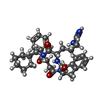 ChemComp-4AI: 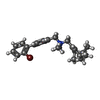 ChemComp-4IE: 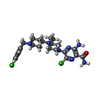 ChemComp-43I: |
| Source |
|
 Keywords Keywords | SIGNALING PROTEIN / G protein coupled receptor / chemokine receptor / CXCR3 / CXCL11 / complex / PS372424 / VUF11222 / SCH546738 |
 Movie
Movie Controller
Controller Structure viewers
Structure viewers About Yorodumi Papers
About Yorodumi Papers




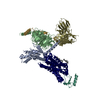





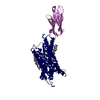
 homo sapiens (human)
homo sapiens (human) oplophorus gracilirostris (crustacean)
oplophorus gracilirostris (crustacean)

